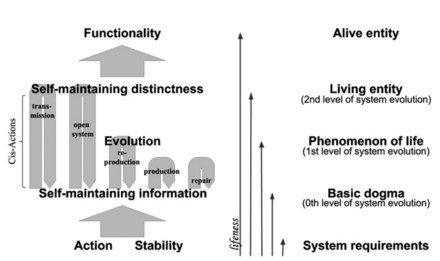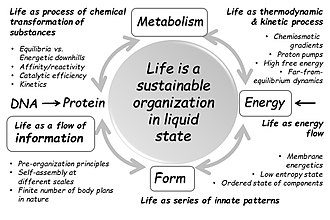Living systems
Living systems are life forms (or, more colloquially known as living things) treated as a system. They are said to be open self-organizing and said to interact with their environment. These systems are maintained by flows of information, energy and matter. Multiple theories of living systems have been proposed. Such theories attempt to map general principles for how all living systems work.
Context
Some scientists have proposed in the last few decades that a general theory of living systems is required to explain the nature of life.[1] Such a general theory would arise out of the ecological and biological sciences and attempt to map general principles for how all living systems work. Instead of examining phenomena by attempting to break things down into components, a general living systems theory explores phenomena in terms of dynamic patterns of the relationships of organisms with their environment.[2]
Theories
Miller's open systems
Lovelock's Gaia hypothesis
The idea that Earth is alive is found in philosophy and religion, but the first scientific discussion of it was by the Scottish geologist James Hutton. In 1785, he stated that Earth was a superorganism and that its proper study should be physiology.[12]: 10 The Gaia hypothesis, proposed in the 1960s by James Lovelock, suggests that life on Earth functions as a single organism that defines and maintains environmental conditions necessary for its survival.[13][14]
Piast's self-maintainable information

All living entities possess
Morowitz's property of ecosystems
A systems view of life treats environmental
Rosen's complex systems biology
Complex systems biology is a field of science that studies the emergence of complexity in functional organisms from the viewpoint of
Bernstein, Byerly and Hopf's Darwinian dynamic
Harris Bernstein and colleagues argued in 1983 that the evolution of order in living systems and certain physical systems obeys a common fundamental principle termed the Darwinian dynamic. This was formulated by first considering how macroscopic order is generated in a simple non-biological system far from thermodynamic equilibrium, and then extending consideration to short, replicating RNA molecules. The underlying order-generating process was concluded to be basically similar for both types of systems.[25][26]
Gerard Jagers' operator theory
Gerard Jagers' operator theory proposes that life is a general term for the presence of the typical closures found in organisms; the typical closures are a membrane and an autocatalytic set in the cell[27] and that an organism is any system with an organisation that complies with an operator type that is at least as complex as the cell.[28][29][30][31] Life can be modelled as a network of inferior negative feedbacks of regulatory mechanisms subordinated to a superior positive feedback formed by the potential of expansion and reproduction.[32]
Kauffman's multi-agent system
Stuart Kauffman defines a living system as an autonomous agent or a multi-agent system capable of reproducing itself or themselves, and of completing at least one thermodynamic work cycle.[33] This definition is extended by the evolution of novel functions over time.[34]
Budisa, Kubyshkin and Schmidt's four pillars

See also
- Artificial life – Field of study
- Autonomous Agency Theory– viable system theory
- Autopoiesis – Systems concept which entails automatic reproduction and maintenance
- Biological organization– Hierarchy of complex structures and systems within biological sciences
- Biological systems– Complex network which connects several biologically relevant entities
- Complex systems– System composed of many interacting components
- Earth system science – Scientific study of the Earth's spheres and their natural integrated systems
- Extraterrestrial life – Life not on earth
- Information metabolism – Psychological theory of interaction between biological organisms and their environment
- Organism – Individual living being
- Spome – Hypothetical matter-closed, energy-open life support system
- Systems biology – Computational and mathematical modeling of complex biological systems
- Systems theory – Interdisciplinary study of systems
- Viable System Theory– concerns cybernetic processes in relation to the development/evolution of dynamical systems
References
- ^ Clealand, Carol E.; Chyba, Christopher F. (8 October 2007). "Does 'Life' Have a Definition?". In Woodruff, T. Sullivan; Baross, John (eds.). Planets and Life: The Emerging Science of Astrobiology. Cambridge University Press.
In the absence of such a theory, we are in a position analogous to that of a 16th-century investigator trying to define 'water' in the absence of molecular theory. [...] Without access to living things having a different historical origin, it is difficult and perhaps ultimately impossible to formulate an adequately general theory of the nature of living systems
- ^ Brown, Molly Young (2002). "Patterns, Flows, and Interrelationship". Archived from the original on 8 January 2009. Retrieved 27 June 2009.
- ISBN 978-0070420151.
- ^ Seppänen, Jouko (1998). "Systems ideology in human and social sciences". In Altmann, G.; Koch, W.A. (eds.). Systems: New paradigms for the human sciences. Berlin: Walter de Gruyter. pp. 180–302.
- ISSN 1092-7026.
- ^ (Miller, 1978, p. 1025)
- ^ Parent, Elaine (1996). "The Living Systems Theory of James Grier Miller". The Primer Project. Retrieved 20 September 2023.
- ^ "The Earth as a System". Primer project ISSS. Retrieved 20 September 2023.
- ^ Seppänen 1998, pp. 197–198.
- ^ Kenneth D. Bailey 2006, pp.292–296.
- ^ Kenneth D. Bailey, 1994, pp. 209–210.
- ISBN 978-0-19-286030-9.
- S2CID 33821197.
- ^ Lovelock, James. "Geophysiology". Papers by James Lovelock. Archived from the original on 6 May 2007. Retrieved 1 October 2009.
- ^ from the original on 15 December 2019. Retrieved 1 January 2023.
- ^ Fiscus, Daniel A. (April 2002). "The Ecosystemic Life Hypothesis". Bulletin of the Ecological Society of America. Archived from the original on 6 August 2009. Retrieved 28 August 2009.
- ISBN 978-0-300-05483-5.
- ISBN 978-1-59947-154-9.
- .
- ISBN 978-0-231-07565-7.
- S2CID 4673166.
- .
- .
- from the original on 17 November 2017.
- S2CID 83956410.
- ISBN 978-0-691-05011-9.
- ISBN 978-90-5011-443-1.
- S2CID 195282529.
- S2CID 195284978.
- from the original on 16 April 2021. Retrieved 16 April 2021.
- ISBN 978-3-642-28110-5.
- PMID 11312589.
- ISBN 978-0-521-83113-0.
- from the original on 11 May 2017.
- PMID 32323410.
Further reading
- Kenneth D. Bailey, (1994). Sociology and the new systems theory: Toward a theoretical synthesis. Albany, NY: SUNY Press.
- Kenneth D. Bailey (2006). Living systems theory and social entropy theory. Systems Research and Behavioral Science, 22, 291–300.
- James Grier Miller, (1978). Living systems. New York: ISBN 0-87081-363-3
- Miller, J.L., & Miller, J.G. (1992). Greater than the sum of its parts: Subsystems which process both matter-energy and information. Behavioral Science, 37, 1–38.
- Humberto Maturana (1978), "Biology of language: The epistemology of reality," in Miller, George A., and Elizabeth Lenneberg (eds.), Psychology and Biology of Language and Thought: Essays in Honor of Eric Lenneberg. Academic Press: 27-63.
- Jouko Seppänen, (1998). Systems ideology in human and social sciences. In G. Altmann & W.A. Koch (Eds.), Systems: New paradigms for the human sciences (pp. 180–302). Berlin: Walter de Gruyter.
- James R. Simms (1999). Principles of Quantitative Living Systems Science. Dordrecht: ISBN 0-306-45979-5
External links
- The Living Systems Theory Of James Grier Miller
- James Grier Miller, Living Systems The Basic Concepts (1978)
